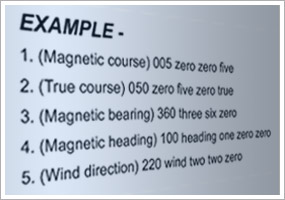| This ePilot Flight Training Edition is sponsored by

Advertisers
                  
Do not reply to this e-mail. Got news? Contact ePilot . Having difficulty using this service? Visit the ePilot Frequently Asked Questions now at AOPA Online or write to [email protected].
Aircraft Owners and Pilots Association
421 Aviation Way
Frederick, MD 21701
Tel: 800/USA-AOPA or
301/695-2000
Copyright © 2008 AOPA. | | Training Tips | | SPEAKING THE NUMBERS
 As you depart on a solo cross-country, you are requested by air traffic control to "say your on-course heading." During preflight planning you calculated a compass heading 10 degrees east of north for your cruise leg. How should you communicate that information in your response to the controller? As you depart on a solo cross-country, you are requested by air traffic control to "say your on-course heading." During preflight planning you calculated a compass heading 10 degrees east of north for your cruise leg. How should you communicate that information in your response to the controller? Aviation radio technique is full of procedural nuances, as student pilots quickly learn. There's the phonetic alphabet to memorize, and figures are rendered in specific formats for critical values such as altitudes, radio frequencies, and directions. It's not safe to communicate casually over an ATC frequency. Who and where you are, and your intentions, must be stated in clearest possible terms. That's why it's so important to identify your aircraft's call sign and location correctly on initial call-ups, and to make sure the controller knows that you understand and will comply with instructions received, as discussed in the Aug. 15 Training Tip on acknowledging ATC clearances. Despite all that, courses and headings remain a common source of confusion for new pilots, especially if the pilot fails to use other safeguards against turning the wrong way. So, getting back to our opening scenario, a pilot using proper radio technique will respond to the controller that he will be flying an on-course heading of "zero-one-zero degrees." See Chapter 4 of the Aeronautical Information Manual for other examples of communicating directions. The key is to always use three digits; north is spoken as "three-six-zero." Sounds easy enough, but more than one pilot has begun the process of getting lost by turning, for example, to a heading of 220 degrees when the correct heading was 022 degrees. Avoid such errors by reviewing the general direction of your course line—north-northeast in the example given above—along with the specific numbers you will expect to see on your heading indicator. "Bug" the new heading at every course change as recommended in the Dec. 3, 2004, Training Tip as an additional safeguard against flying in the wrong direction. Communicating directions in three digits may seem at first like a tedious procedural ritual—until the day comes when doing so saves you from a costly or dangerous error!
| | Your Partner in Training | | As an AOPA member, you also have access to AOPA's flagship publication: AOPA Pilot. Visit the AOPA Pilot magazine archives on AOPA Online for a wealth of information right at your fingertips. From training information to safety articles to legal issues to aviation careers—and more—be sure to take advantage of this additional AOPA member benefit to get the most out of your training. Did you know that student pilots who join AOPA are three times more likely to complete their flight training? Membership includes unlimited access to aviation information by phone (800/USA-AOPA, weekdays from 8:30 a.m. to 6 p.m. Eastern time) or from AOPA Flight Training Online or AOPA Online. If you're not already a member, join today and get the pilot's edge. Login information is available online.
| | Flight Training News | | EMBRY-RIDDLE EARNS TOP SPOT ON COLLEGE LIST
Embry-Riddle Aeronautical University has earned a top spot in the U.S. News & World Report's 2009 America's Best Colleges guide. The Daytona Beach, Fla., campus was ranked first among aerospace/aeronautical/astronautical engineering programs where the highest degree is a bachelor's or master's. The U.S. Air Force Academy was second, followed by Embry-Riddle's Prescott, Ariz., campus. Fourth place was the U.S. Naval Academy, and fifth place was Cal Poly-San Luis Obispo. In related news, Embry-Riddle announced plans to offer a doctoral degree in aviation. Pending accreditation, the program will be available in 2009. NEW MINICOURSE RE-CREATES VFR-INTO-IMC ACCIDENT
Low ceilings and reduced visibility kill more pilots every year than all other weather phenomena combined. That's why the AOPA Air Safety Foundation chose this topic for the debut installment of a dramatic new minicourse series. Accident Case Study: VFR Into IMC uses Microsoft Flight Simulator, professional narration, and actual ATC audio from the day of the accident to re-create events leading up to a fatal 2006 crash near Heber City, Utah. Once the cautionary tale is complete, the cause of the crash is thoroughly examined. By highlighting the many opportunities the pilot had to reverse his fate, the goal is to help others avoid sharing it. The minicourse runs 20 to 30 minutes. NEW AVIATION DEGREES AT CENTRAL WASHINGTON UNIVERSITY
Central Washington University in Ellensburg, Wash., is offering additional aviation degrees at its Moses Lake center, located on the campus of Big Bend Community College (BBCC). In addition to a bachelor of science in aviation management, aviation students now will be able to receive a flight officer specialization, commercial pilot specialization, and aviation maintenance management specialization. Students at Moses Lake earn their flight or mechanics training through BBCC, and then transfer directly into the Central degree program at Moses Lake. The degrees are offered as a collaborative effort between Central's department of aviation and BBCC's aviation and aviation mechanics departments.
| | Inside AOPA | | GIVE YOUR MEDICAL CERTIFICATE KNOWLEDGE A CHECKUP
Many people dread a visit to the doctor, but as a pilot, knowing your medical condition is a must. And with recent changes to the duration of some medical certificates, it's a good idea to brush up your knowledge of aviation medical certification. Can a family physician issue your medical certificate? Which allergy medications are you allowed to take? What happens if a pilot is cited for DUI? Give your medical certificate awareness a thorough checkup with the latest Safety Quiz from the AOPA Air Safety Foundation. Previous quizzes are available online. LAST CHANCE TO ENTER PHOTOS IN 'AOPA PILOT' PHOTO CONTEST
With only five days left, don't wait to enter your favorite general aviation photos for a chance to win cash prizes totaling $5,000, including a grand prize of $1,000. All entries must be received by AOPA by 5 p.m. Eastern Daylight Time on Sept. 2. Winning photographs and selected finalists will be published in the December 2008 issue of AOPA Pilot. See AOPA Online for complete contest rules and tips from AOPA's staff photographer. FLIGHT INSTRUCTORS: PROTECT YOURSELF—AND YOUR LIVELIHOOD
Flight instructors can be held liable for their students' incidents, even if the CFI was not on board the aircraft at the time. When shopping for aviation coverage, look for a policy that is designed to meet the unique needs of CFIs. See AOPA's checklist of items to look for when shopping for coverage.
| | Training Products | | SPORTY'S AOPA FLASHLIGHT
Sporty's Pilot Shop has introduced a new four-color AOPA flashlight for pilots. The flashlight features the AOPA wings logo and four independent switches to control the white, blue, red, and green light beams. A high-intensity white light is also available to use for the aircraft preflight inspection. The flashlight measures three and three-quarters inches long and uses three AAA batteries. It sells for $59.95. Order online or call 800/SPORTYS. Note: Products listed have not been evaluated by ePilot editors unless otherwise noted. AOPA assumes no responsibility for products or services listed or for claims or actions by manufacturers or vendors.
| | Final Exam | | Question: I am a student pilot, and my airport lies under Class B airspace. Am I able to fly solo in the Class B airspace? Answer: As a student pilot, you are allowed to fly in Class B airspace after receiving an endorsement showing ground and flight training from an authorized instructor in the specific Class B airspace area for which the solo flight is authorized. The logbook endorsement must be dated within the 90-day period preceding the date of the flight. If you elect to land at an airport within the Class B airspace, you must receive additional training and an endorsement from your instructor specific to that airport, per FAR 61.95(a) and (b). Your aircraft must be equipped with, at minimum, a two-way radio, capable of communicating with air traffic control, and an altitude-encoding transponder. Read more in this article from AOPA Flight Training . Got a question for our technical services staff? E-mail to [email protected] or call the Pilot Information Center, 800/872-2672. Don't forget the online archive of "Final Exam" questions and answers, searchable by keyword or topic.
| | What's New Online | | SITUATIONAL AWARENESS GALORE
It used to be that flying from one airport to another was done with a chart, a compass, and a stopwatch. Times have changed. Today's multifunction displays tell us where we are at all times, and most even display other airplanes and weather. This year's AOPA Get Your Glass Sweepstakes Piper Archer features an Avidyne EX500, a highly capable tool. Stop by this week's sweepstakes update to learn more.
| | Picture Perfect | | Looking for some really fabulous aviation photography? All the air-to-air photos and beautifully detailed ground images used by AOPA Pilot magazine over the years are yours at the click of a mouse button. Download your favorite images to use for wallpaper or send an e-postcard. For more details, see AOPA Online.
| | Aviation Events & Weather | | Want something to do this weekend? Wanting to plan an aviation getaway? See our online calendar of events. We’ve enhanced our calendar so that with one click, you can see all of the events listed in the calendar regions you selected when personalizing ePilot. Now you can browse events listed two weeks to a few months out to make your planning easier. Before you take off on an adventure, make sure you check our current aviation weather provided by Jeppesen. To submit an event or to search all events in the calendar visit AOPA Online. For airport details, including FBO fuel prices see AOPA's Airport Directory Online. FLIGHT INSTRUCTOR REFRESHER CLINICS
The next AOPA Air Safety Foundation Flight Instructor Refresher Clinics are scheduled in Phoenix, Ariz., Colorado Springs, Colo., and Sacramento, Calif., Sept. 6 and 7; in Richmond, Va., Sept. 13 and 14; and in Baltimore, Md., and Seattle, Wash., Sept. 20 and 21. For a complete schedule, see AOPA Online. Can't make it in person? Sign up for the CFI Refresher Online. AOPA AIR SAFETY FOUNDATION SAFETY SEMINARS
AOPA Air Safety Foundation Safety Seminars are scheduled in Wichita, Kan.; Ypsilanti, Mich.; and Germantown, Tenn., on Sept. 8. Topics vary-for details and a complete schedule, see AOPA Online. | |






















 As you depart on a solo cross-country, you are requested by air traffic control to "say your on-course heading." During preflight planning you calculated a compass heading 10 degrees east of north for your cruise leg. How should you communicate that information in your response to the controller?
As you depart on a solo cross-country, you are requested by air traffic control to "say your on-course heading." During preflight planning you calculated a compass heading 10 degrees east of north for your cruise leg. How should you communicate that information in your response to the controller? 

